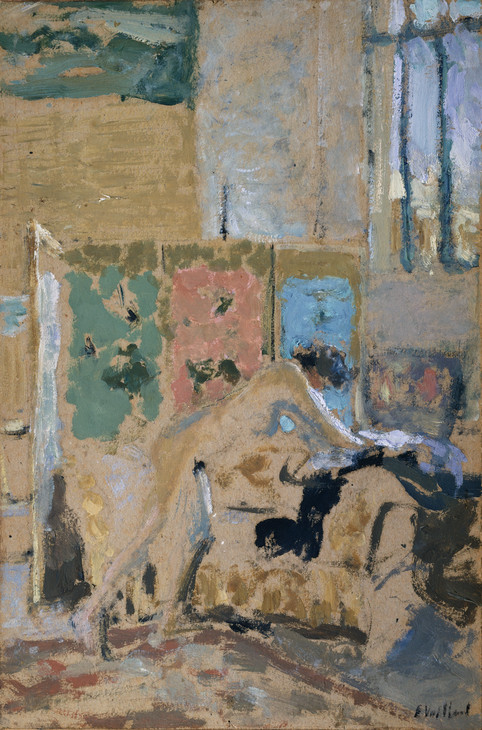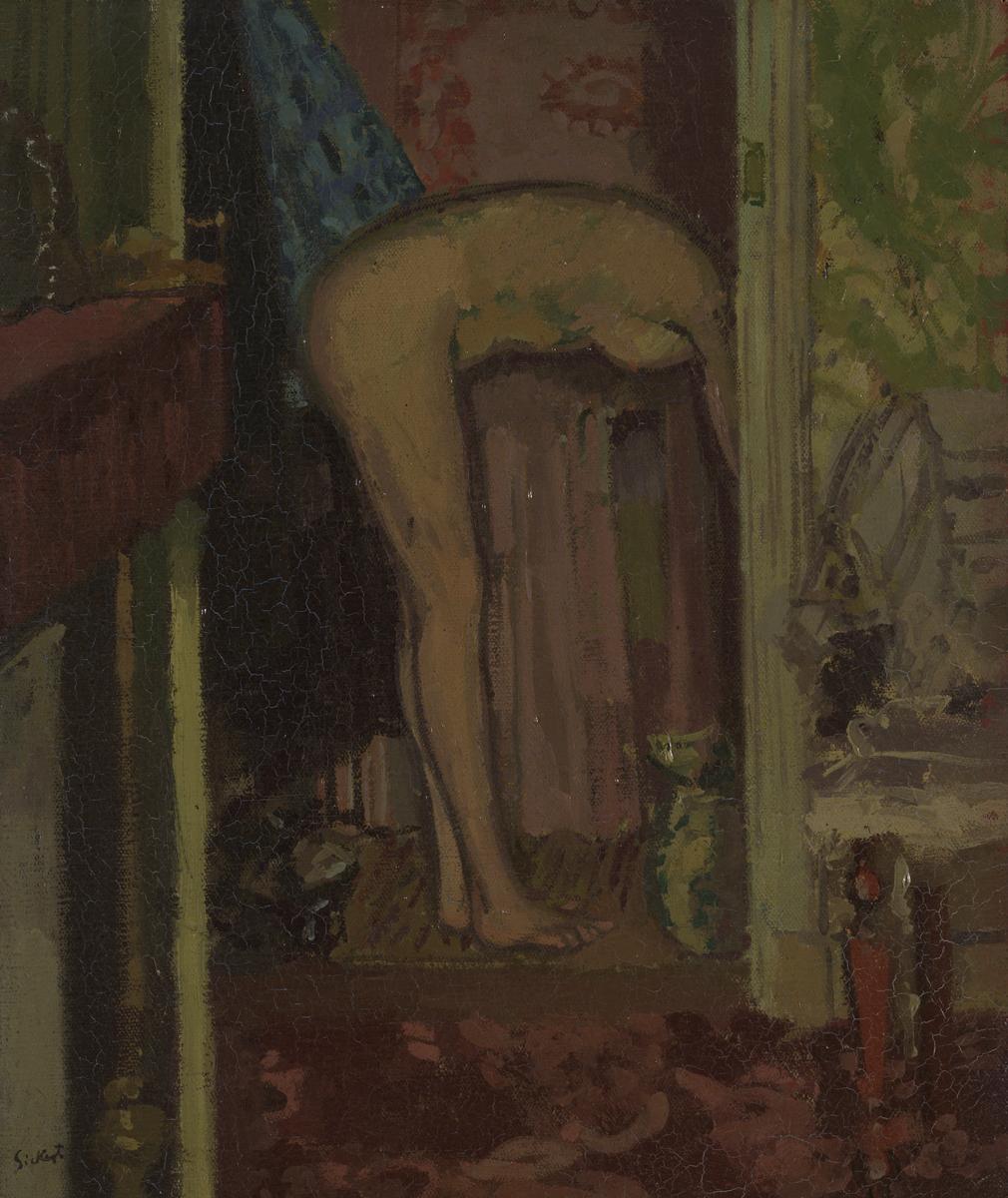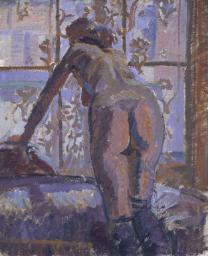Walter Richard Sickert Woman Washing her Hair 1906
Walter Richard Sickert,
Woman Washing her Hair
1906
Walter Sickert painted this work in his room at the Hôtel du Quai Voltaire, Paris, where he stayed in 1906. The strong diagonal of the mantelpiece in the foreground draws the viewer’s eye into the centre of the rectangular composition, where a woman, her head obscured by the line of the wall, leans over a basin ostensibly washing her hair. The voyeuristic sense of the scene follows in the tradition of modern French painting, which depicted naked women in contexts that were neither mythological nor academic.
Walter Richard Sickert 1860–1942
Woman Washing her Hair
1906
Oil paint on canvas
457 x 381 mm
Inscribed by the artist ‘Sickert’ in black paint bottom left
Bequeathed by Lady Henry Cavendish-Bentinck 1940
N05091
1906
Oil paint on canvas
457 x 381 mm
Inscribed by the artist ‘Sickert’ in black paint bottom left
Bequeathed by Lady Henry Cavendish-Bentinck 1940
N05091
Ownership history
Bought from the artist by Bernheim-Jeune Gallery, Paris, 1910; acquired by Lord Henry Cavendish Bentinck (1863–1931), London, 1927; inherited by his wife, Lady Henry Cavendish-Bentinck, by whom bequeathed to Tate Gallery 1940.
Exhibition history
1907
Exposition Sickert, Bernheim-Jeune, Paris, January 1907 (21, as ‘La Toilette’).
1925
?Goupil Gallery, London, Spring 1925 (71).
1944
The Tate Gallery’s Wartime Acquisitions Second Exhibition, (Council for the Encouragement of Music and Arts tour), Manchester City Art Gallery, November–December 1944, City Museum and Art Gallery Birmingham, January–February 1945, Walker Art Gallery, Liverpool, March 1945, Central Museum and Art Gallery, Derby, April 1945, Wakefield Art Gallery, May–June 1945, Castle Museum, Norwich, July–August 1945, Laing Art Gallery, Newcastle upon Tyne, September–October 1945, Worthing Museum and Art Gallery, October–November 1945 (70).
1945
The Tate Gallery’s Wartime Acquisitions Second Exhibition, National Gallery, June–July 1945 (67).
1948
Annual Exhibition of the Royal Scottish Academy, Edinburgh 1948 (259).
1989–90
W.R. Sickert: Drawings and Paintings 1890–1942, Tate Gallery, Liverpool, March 1989–February 1990, Tate Gallery, London, July–September 1990 (5, reproduced).
1993
The Painted Nude, Norwich Castle Museum, Norwich, May–September 1993 (no number).
1998
Masterpieces of British Art from the Tate Gallery, (British Council tour), Tokyo Metropolitan Art Museum, January–March 1998, Hyogo Prefectural Museum of Modern Art, Kobe, April–June 1998 (82, reproduced).
2001–3
Exposed: The Victorian Nude, Tate Britain, London, November 2001–January 2002, Haus der Kunst, Munich, March–June 2002, Brooklyn Museum of Art, New York, September 2002–January 2003, Kobe City Museum, February–May 2003, Geidai Museum, The University Art Museum, Tokyo, June–August 2003 (165, reproduced).
2005–6
Degas, Sickert and Toulouse Lautrec: London and Paris 1870–1910, Tate Britain, October 2005–January 2006 (92, reproduced).
2008
Modern Painters: The Camden Town Group, Tate Britain, London, February–May 2008 (56, reproduced).
2010
The Art of Walter Sickert, The Lightbox, Woking, May–July 2010 (no catalogue).
References
1927
James Bolivar Manson, ‘Walter Richard Sickert, A.R.A.’, Drawing and Design, vol.3, July 1927, reproduced p.4.
1955
Anthony Bertram, Sickert, London and New York 1955, reproduced pl.19.
1960
Lillian Browse, Sickert, London 1960, p.101, as Woman Washing Hair, Le Cabinet de Toilette, No.2.
1964
Mary Chamot, Dennis Farr and Martin Butlin, Tate Gallery Catalogues: The Modern British Paintings, Drawings and Sculpture, vol.2, London 1964, p.630, reproduced pl.37.
1970
Wendy Baron, ‘Sickert’s Links with French Painting’, Apollo, vol.91, March 1970, pp.195, 197, reproduced fig.15.
1973
Wendy Baron, Sickert, London 1973, no.248, p.93, pl.170.
1979
Wendy Baron, The Camden Town Group, London 1979, p.390.
1980
Simon Watney, English Post-Impressionism, London 1980, reproduced fig.17.
1981
Andrew Causey and Richard Thomson (eds.), Harold Gilman 1876–1919, exhibition catalogue, Arts Council, London 1981, p.5, reproduced fig.1.
1992
Wendy Baron and Richard Shone (eds.), Sickert: Paintings, exhibition catalogue, Royal Academy, London 1992, p.184, reproduced fig.138, as Le Cabinet de Toilette.
2000
Wendy Baron, Perfect Moderns: A History of the Camden Town Group, Aldershot and Vermont 2000, pp.204–5.
2001
David Peters Corbett, Walter Sickert, London 2001, p.32.
2003
Below Stairs: 400 Years of Servants’ Portraits, exhibition catalogue, National Portrait Gallery, London 2003, p.117.
2006
Wendy Baron, Sickert: Paintings and Drawings, New Haven and London 2006, no.272, pp.[63], 324, reproduced.
2007
Barnaby Wright (ed.), Walter Sickert: The Camden Town Nudes, exhibition catalogue, Courtauld Gallery, London 2007, p.36, reproduced fig.34, p.76.
Technique and condition
Walter Sickert used a relatively coarsely woven, commercially primed canvas on a fixed strainer. He painted directly in oil over the off-white priming. The white ground is covered in most places and plays little part in the final image. The development of the layer structure is difficult to interpret and no toned ground or drawing is discernible. It is generally thickly painted although there is little localised high impasto. The painting shows signs of being reworked in places. It is possible that Sickert struggled with parts of this composition: some bright blue is visible within the cracks, which may relate to a change in the composition or at least a very different colour scheme underneath. The paint is medium rich and drying cracks have formed where it is heavily built up in successive layers. Overall, the surface shows signs of the wet paint slumping, with the consequence that the brushwork is not crisp. There is a soft resin varnish layer that may be original.
Stephen Hackney
June 2004
How to cite
Stephen Hackney, 'Technique and Condition', June 2004, in Nicola Moorby, ‘Woman Washing her Hair 1906 by Walter Richard Sickert’, catalogue entry, July 2009, in Helena Bonett, Ysanne Holt, Jennifer Mundy (eds.), The Camden Town Group in Context, Tate Research Publication, May 2012, https://wwwEntry
In October 1906 Walter Sickert exhibited ten pictures at the Salon d’Automne in Paris, and arrived in the capital from Dieppe in order to attend the opening. He took a room at the Hôtel du Quai Voltaire, on the Left Bank of the Seine directly opposite the Louvre, which he described as ‘my enchanting hotel a few doors off the house where Ingres died’, where apparently the ‘alcove of the beds in some of the rooms are beautifully lit’.1 Much favoured by artists and writers during the late nineteenth and early twentieth centuries, previous patrons of the hotel included Richard Wagner, Charles Baudelaire and Camille Pissarro, who had painted a number of views from a window on the third floor during 1903.2 Sickert himself had first stayed there in 1883, in the company of Oscar Wilde (who later died there in 1900). The purpose of that visit had been to deliver Whistler’s iconic portrait of his mother to the Salon, but the trip also marked the occasion of Sickert’s first meeting with Edgar Degas, the French painter who was to have such a profound influence on the direction of his art. Possibly stimulated by memories of that significant moment in his career, or simply enthralled by the artistic ferment of Parisian life, during his visit in 1906 Sickert opted to stay in the hotel for some weeks, during which time he used the room as a studio and produced a large number of paintings and drawings. He wrote to his friend, the painter William Rothenstein, that he was ‘doing a whole set of interiors in the hotel, mostly nudes’, as well as some theatrical subjects.3 This burst of creativity led to a successful solo exhibition at the Bernheim-Jeune Gallery in January 1907. Woman Washing her Hair dates from this period. Painted in the Hôtel du Quai Voltaire, it was exhibited at Bernheim-Jeune under the title, La Toilette, and later acquired by the gallery in 1910.4
The young, slim model for Woman Washing her Hair was a French girl named Blanche whom Sickert later described as ‘most enchanting ... the thinnest of the thin like a little eel, exquisitely shaped, with red hair’.5 He recalled that:
My little model ... Blanche ... called the part she sat upon ‘ma figure de dimanche’ and had endless other endearing sayings. I think the drollest comedy situation ever invented was given by her, as illustrating the correct attitude of a figure-model towards a lady she supposes to be the painter’s wife. She was sitting fully dressed with a big hat & plumes on a summer’s day, before a sitting, drinking a cup of tea with me. A lady whom she erroneously imagined to be my wife entered unexpectedly to visit me. ‘O pardon madame’ exclaimed Blanche, rose, hurled her hat, her [dress], & her clothes off & threw herself onto the bed in the position of my picture! For her to be caught hob-nobbing dressed was the inconvenience.6
In this picture Blanche is seen in profile, standing within a closet or bathroom space, bent at the waist with her legs straight and her back curved. As suggested by the title of the picture she is ostensibly in the process of washing her hair over a basin, although her head is hidden from the viewer by the line of the wall. There is a china jug on the floor at her feet and a pink towel draped over a stand behind her. Her clothes appear to have been left on a chair on the right-hand side of the picture, while in the left-hand foreground there is a fireplace surmounted by a shelf and a mirror. The eye of the viewer is led towards the centre of the composition by the strong diagonal of the mantelpiece. The patterned floral green wallpaper is echoed by the swirls evident within the design of the carpet. The art historian Wendy Baron has documented two further paintings which appear to feature the same model in the same corner of this interior. Le Cabinet de Toilette (Count Natale Labia, Cape Town)7 depicts Blanche standing full length with her arms raised behind her head, while Seated Nude (private collection),8 shows her seated with her hands on her hips. Baron has also noted a related sketch in chalk and pen, Nude Girl Lying on her Front (private collection),9 which appears to feature the same model, and two paintings, La Maigre Adeline and Jeanne,10 which depict full-length nudes lying across a bed, also in the same room. A further series of paintings and drawings dating from the same period features a plumper, more curvaceous sitter.11

Edouard Vuillard 1868–1940
Interior with a Screen 1909–10
Oil paint on paper on cardboard on panel
358 x 238 mm
The Samuel Courtauld Trust, The Courtauld Gallery, London
Photo © The Samuel Courtauld Trust, The Courtauld Gallery, London
Fig.1
Edouard Vuillard
Interior with a Screen 1909–10
The Samuel Courtauld Trust, The Courtauld Gallery, London
Photo © The Samuel Courtauld Trust, The Courtauld Gallery, London
As well as following the French genre of Manet’s Olympia 1863 (Musée d’Orsay, Paris),16 and other paintings of realistically portrayed contemporary women, the depiction of the nude is entirely in line with Sickert’s own firmly held views on the presentation of naked figures. He believed that paintings should always show ‘someone, somewhere’,17 and he condemned art school practice which taught students to draw idealised, ‘lifeless’ nudes without reference to the real world.18 Instead, he articulated, the focus should be placed on drawing people set within the context of a real environment where their nakedness made some sense. His approach here parallels his Venetian and London interiors of lower class women posed within shabby domestic spaces. The cropped view of the headless body creates an impersonal anonymity which is negatively prurient. Yet despite the cluttered claustrophobia of the hotel room and the voyeuristic sense of gazing at a woman who is unaware of being observed, the painting lacks the disturbing ambivalence and grimy atmosphere which pervades so many of his Camden Town pictures (see La Hollandaise, Tate T03548).
Nicola Moorby
July 2009
Notes
See Camille Pissarro, Le Quai Malaquais et l’Institut 1903, in Impressionist / Modern Evening Sale, Christie’s, London, 23 June 2009 (lot 7, reproduced).
Walter Sickert, letter to William Rothenstein, 1906; quoted in Wendy Baron and Richard Shone (eds.), Sickert: Paintings, exhibition catalogue, Royal Academy, London 1992, p.184.
24 December 1910, stock number 18500, Wendy Baron, Sickert: Paintings and Drawings, New Haven and London 2006, pp.[63] and 324.
See, for example, Alison Smith (ed.), Exposed: The Victorian Nude, exhibition catalogue, Tate Britain, London 2001, no.165, p.256 and Robert Upstone (ed.), Modern Painters: The Camden Town Group, exhibition catalogue, Tate Britain, London 2008, no.56, p.120.
See, for example, Wendy Baron, ‘Sickert’s Links with French Painting’, Apollo, vol.91, March 1970, p.195, Penelope Curtis, Richard Shone et al., W.R. Sickert: Drawings and Paintings 1890–1942, exhibition catalogue, Tate Gallery, Liverpool 1989, no.5, p.19, Smith (ed.) 2001, no.165, p.256, and Barnaby Wright (ed.), Walter Sickert: The Camden Town Nudes, exhibition catalogue, Courtauld Gallery, London 2007, p.36.
Baron 2006, [p.63]; see also Wendy Baron, Sickert, London 1973, p.93. Bonnard’s painting was reproduced in the Gazette des Beaux-Arts, vol.36, 1906, p.475.
Anna Gruetzner Robins and Richard Thomson, Degas, Sickert and Toulouse Lautrec: London and Paris 1870–1910, exhibition catalogue, Tate Britain, London 2005, pp.164–6.
Reproduced at Musée d’Orsay, Paris, http://www.musee-orsay.fr/en/collections/works-in-focus/painting.html?no_cache=1&zoom=1&tx_damzoom_pi1%5BshowUid%5D=4042 , accessed August 2009.
Walter Sickert, ‘On the Conduct of a Talent’, New Age, 11 June 1914, p.131, in Anna Gruetzner Robins (ed.), Walter Sickert: The Complete Writings on Art, Oxford 2000, p.377.
Related biographies
Related essays
- Walter Sickert: ‘The naked and the Nude’ Barnaby Wright
Related catalogue entries
Related reviews and articles
- Walter Richard Sickert, ‘Idealism’ The Art News, 12 May 1910, p217..
- Walter Richard Sickert, ‘The naked and the Nude’ The New Age, 21 July 1910, pp.276–7.
How to cite
Nicola Moorby, ‘Woman Washing her Hair 1906 by Walter Richard Sickert’, catalogue entry, July 2009, in Helena Bonett, Ysanne Holt, Jennifer Mundy (eds.), The Camden Town Group in Context, Tate Research Publication, May 2012, https://www




